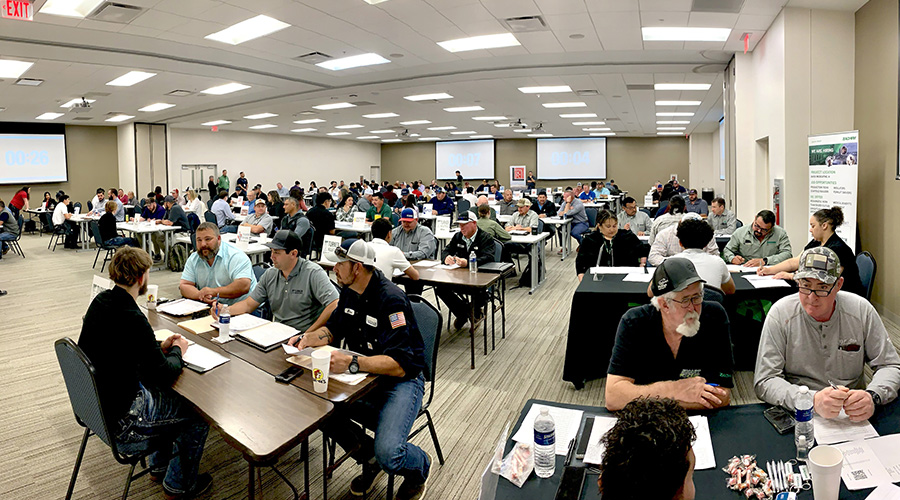FACES OF THE FUTURE
Energetic and ambitious, a new generation of facility managers is making its mark. Meet Michael Rueda and other leaders of tomorrow
By Naomi Millán, Associate Editor
When Michael Rueda, 33, entered facilities management a decade ago, he didn’t even know what it was. He started out at Countrywide Financial in Calabasas, Calif., as a temp in the mailroom. After a promotion didn’t work out as intended, a frustrated Rueda snapped up a job offered by the building manager.
“I’ll go into facilities, whatever that is,” Rueda remembers thinking. He quickly developed an affinity for the field.
“In the facilities world, you can never know enough,” he says. He describes a day where, while bouncing between meetings, he dealt with a scheduled power shut down, mold remediation, a contracting firm and a broken pipe.
The pressure doesn’t faze him. “I thrive in this environment,” he says. “My dad is a firefighter. Walking into a building on fire, that’s stress. I sometimes just have a lot of work to do.”
After coming up through the ranks, at 29 he became the building manager of Countrywide Financial’s 600,000-square-foot, three-building headquarters, becoming the youngest building manager in the organization’s portfolio.
“I’ve been very aggressive with my career path,” Rueda says. “I’m living proof that you can come from nothing and make it.” Rueda says he intends to continue moving up, with the vice president of the Calabasas region position in his sights.
Young facility executives are a rarity in facilities management. The reasons are complex. They include a lack of understanding of the field in the general population, which lends a degree of invisibility to the profession, and a historically static structure in the field that created few entrance points for newcomers.
Regardless, in a field where a large percentage of the population is due to retire in the next decade or so, opportunities for advancement are tantalizing for young facility executives.
Consider that the average facility executive is 48 years old, according to a recent International Facility Management Association (IFMA) survey of 4,600 facility executives. The Profiles 2007 report found that the youngest age bracket, those under 35, make up only 7 percent of the population. These numbers are not exactly news to anyone in the industry.
Sticking Around
When facilities management came into its own a few decades back, the ranks were filled from seasoned professionals already situated in the field. Many came from in-house departments like interior design and real estate, as well as external fields like architecture and the trades. Those early facility executives didn’t have much interest in moving around, says Stormy Friday, president of the Friday Group.
“We found in the facilities management world people would stay in their existing company for 20 or 30 years, which is far longer than is typical,” Friday says. “They don’t move around and they don’t leave.” By contrast, in high tech companies, the average tenure is three to six years.
The variety of daily tasks and long-term projects that makes Rueda excited about his work is the same reason facility executives tend to stay.
“It’s an interesting environment. You see the whole purview of a company,” Friday says. “You can stay within your area but also take on a lot of different challenges.”
With everyone happily staying put, there was little room for new entrants and no need to pursue or train them. However, in the 1990s, the industry began to change, Friday says. There was an increased interest in metrics to show how staff and budget resources were being used. This new level of accountability spurred restructuring and a lot of in-house people left to work for outsourcing firms, she says. This shift is one of the reasons young newcomers started making their ways into the field.
The stories of five facility executives, ranging in age from 24 to 35, offer some insight into what the new generation is like. They share an ability to quickly assimilate new technology and easily interface with their entire organization, from the boiler room to the boardroom. While the under-35 group might be a little lonely for company, at least there’s not a crowd of FMs their age blocking the path to the top.
Winding Road
Working for Jones Lang LaSalle on the UnitedHealth Group account, Sean Doyle, 31, knows all about the dynamics of outsourcing.
“It makes the workplace much more competitive,” says Doyle. “There’s lots of turnover.”
However, that turnover creates growth opportunities. When Doyle graduated with his MBA and started looking for a job, an ad in the paper for a position with Trammell Crow Co. caught his eye.
“It was a nice fit, but definitely something I never planned on,” he says. He signed on as an assistant facility manager in August 2005, and is now the facility manager of seven buildings totaling 350,000 square feet.
What Doyle likes best about his job is the customer-service side of it. “It’s not a glamorous job and you can get your hands dirty at times, but facility management is a valuable component to the successful operation of a company,” he says.
Kendra Gastright, 35, associate director, systems engineering division at the Smithsonian Institution, also had not planned on facilities management. At a time when combat was not an option for women in the Navy, she started her career as the facility manager of Bancroft Hall at the U.S. Naval Academy while going to night school for her masters in engineering.
“From there, I grew my passion,” she says. When she switched to civilian life, she chose a museum facility manager position at the National Air and Space Museum. In her current position since 2006, she works in all 700 facilities in the Smithsonian’s portfolio, totaling 12 million square feet.
Gastright was interested in the field because the facility managers in the Navy seemed to have the answer for everything. “That person seemed to be in touch with everyone and solve everyone’s problems,” she says. “It was inspiring to see how doing a good job can positively impact others.”
With an engineering background, the access to high-tech challenges also keeps her interested. At the Smithsonian she deals with high-voltage systems, vertical transportation, and on.
“Systems engineering is at the cutting edge of technology,” Gastright says. “All these technologies and skilled craftsmen are in my hand. What’s not heady about that?”
Dawn of the Diploma
While the IFMA Profiles report found only 7 percent of respondents had come directly into facilities management, the rise of degree and certificate programs in facilities management might change that statistic.
Damon Gonzales, 29, came out of Ferris State University’s facilities management degree program 41/2 years ago. After graduation, he returned to work for the Collier County Government, where he had interned the year before. After working as their CAD technician for 18 months, he was hired as the facilities manager.
The position hasn’t come just from having the degree, though. Even as an intern, he let it be known he had his eye on the position. “I took steps to get ready for when the position opened up, like getting involved in the budget,” Gonzales says. He also worked on achieving the certified facility manager designation.
With a portfolio of more than 3 million square feet of space in over 640 county buildings, Gonzales was attracted to the position because of the large range of facilities to manage, everything from fire stations to libraries, with customers like state senators and congressmen.
Even though facilities management is listed in the course catalog, students still discover the field accidentally. Originally, Gonzales started an associate’s degree in architecture at Ferris. When he saw there was a bachelor’s degree available in facilities management, he checked out some classes and liked it.
Anne Moser, 24, had a similar experience. She had always loved buildings and considered architecture as a major, but when she started at Brigham Young University, it was in business consulting. However, she found the overly competitive atmosphere was not a good match. Flipping through the course catalog, she saw the facilities management major and was intrigued.
“It seemed perfect. It combined my love of buildings with management with organizational psychology,” Moser says. She hadn’t dreamed of being able to add consulting to that mix until her current employer, Facility Engineering Associates, came recruiting.
Moser says her classmates were always surprised when they learned of the rare freshman starting out as a facilities management major, though there slowly seem to be more of them, she says.
Where is Everybody?
Friday discounts the notion that facilities management is invisible. For example, she talks about the first time she saw facilities management mentioned in a Dilbert cartoon. “Gosh, we have arrived,” she remembers thinking. So the dearth of younger workers in the field is not because it’s invisible, she says. It’s just not well understood.
What’s more, Friday sees tremendous opportunities for advancement available to younger workers. One reason: During restructuring in the 90s, many middle managers got squeezed out, she says. When Gastright started her job at the National Air and Space Museum she saw herself staying in her position for at least ten years. But a third of her bosses are due for retirement.
“I wasn’t climbing that ladder, but the opportunities are there. It’s amazing,” Gastright says. “I can’t understand where my peers are.”
The consulting firm Moser works for only launched a facilities management department 41⁄2 years ago, a year before they hired her. The department has grown from just her and another BYU grad to a 10-person team. That’s still only one-sixth of the total company, which has afforded Moser a lot of exposure.
“I’ve been surprised at the opportunities I’ve had to work with major clients,” she says.
The Future is Now
One of the big ways the facilities management field is changing is in the use of more advanced technology.
“The future of facilities management is happening right now,” says Gastright. The industry is not as manpower-intensive. It’s starting to go towards wireless, predictive technology instead of time-based tasks, she says. A younger worker might have some advantages in that environment.
“The current generation of facility executives is not trained for that future,” Gastright says. “They weren’t raised or trained to do the administrative or technical requirements of the job.”
Gonzales takes advantage of technology to maintain a smaller in-house staff. As a county entity, his department has to be careful not to hog taxpayer resources.
“It means we have to be smart about managing technology and outsourcing,” he says. His team manages a building automation center that controls 7,500 building automation points, monitors over 470 cameras, and manages more than 9,400 cardholders, among other functions.
Facilities management teams are also now expected to be more of a corporate partner. Doyle perceives the field as evolving into a more administrative and strategic role, such as with space planning, forecasting growth and budgeting. There are more responsibilities, but they’re not as hands on.
“A facility manager is expected to be a partner in the execution of the business plan,” he says. “A good facility executive has good customer service skills, good business sense for navigating and mapping business strategy, good organization and good financial know-how.” He suggests hiring for the business sense and investing in industry-specific training once they’re onboard.
Mind the Age Gap
Though young facility executives see themselves as having strengths in areas like technology and general adaptability, they are respectful of knowledge that only comes through years of experience. They’ve learned to rely on their team’s expertise.
Gonzales says most of his job is managing people, which surprised him. How to earn the respect of his peers and subordinates was not something he could learn in a book, he says. “When you first come in, work hard, trust the people who work under you and utilize the resources you have,” he says.
Beyond giving the respect due to someone who has been in the field for 20 years, Doyle says it’s important to learn from them. “You need to use their resources and expertise,” Doyle says. “In facilities management, there’s a fifty-fifty split between knowledge and the hands-on know-how of the mechanicals. You need to have the mechanical know-how so you’re not bamboozled by a contractor and so you can communicate your needs.”
Sometimes it’s not easy being young. Gaining the team’s or the customer’s respect and confidence may be initially difficult. Moser says there’s a joke in her firm that grey hair is needed before one is taken seriously. Even consultants in their 40s who look young face a little bit of a hurdle, she says. Being a young woman compounds the issue.
“I often get the look of, ‘Well, what do you really know?’” she says. However, once she has the initial meeting with the client, she jumps the age-perception hurdle pretty quickly.
Growth and Success
Facility executives looking to attract and retain younger workers might want to take a few factors into account. For one thing, Friday suggests there is always dichotomy in an intergenerational workforce. In the ’70s and ’80s, she says, facility executives would joke about how much time they had to spend on the job, like coming in on the weekends.
“A younger worker is not going to do that. A younger worker expects that because they come with credentials, they have an established career path,” Friday says. That’s not a realistic expectation. “They bring a lot to the table, but a lot also comes with understanding an organization’s culture and a particular building.”
Even if some expectations of younger facility professional are unrealistic, understanding that these preconceptions might exist could give superiors a leg up on preventing attrition. For example, Moser says most of the graduates in her class have already changed jobs once.
“A lot are going to work for large outsourcing firms and get put into roles that are not challenging. They want to stay, but aren’t finding their niche,” she says, adding that it has to do with variety and opportunities. “If you get stuck doing the same thing over and over again, you get bored.”
One way to counteract that boredom is to offer training. Doyle says the training opportunities both inside companies and through outside organizations could be improved, especially because so many people come to facilities management through different avenues. He suggests media that is interactive and accommodating to a busy life-style, such as one-day seminars or Web-courses, would be well-received. In a podcast, Web-phone, Blackberry world, plopping a training manual on a new hire’s desk is not going to cut it. Training could also be a good method for capturing and transmitting the decades of knowledge from senior team members to the new ranks.
In the end, it’s not a question of out with the old and in with the new, but striking a balance. Mixing the great institutional knowledge of established facility executives with the new ways of thinking and processes of younger facility executives is surely a recipe for continued success in facilities management.
Advice on the Way Up
Young facility executives, degree in hand or not, have a lot to learn in order to succeed. Here are some peer-to-peer pointers.
Michael Rueda, building manager with Countrywide Financial, says finding a good mentor, one who is successful and ambitious, helped him. Another important aspect is ownership. “The key to success is ownership. It’s my building. It’s my tree,” he says.
Establishing a good network is another important goal, says Sean Doyle, facility manager with Jones Lang LaSalle. “It’s important to focus on training and networking. Stay involved in a network with other facility executives. Establish some recognition within your area,” he says.
Anne Moser, facility management consultant with Facility Engineering Associates, agrees that making a name for yourself is important for young facility executives. “Don’t be afraid to make mistakes and put yourself out there,” she says. “Also, don’t be so arrogant because you have a degree in the field. Having the education helps to push you forward, but you still need to get the institutional knowledge, which is crucial.”
|
Related Topics:











